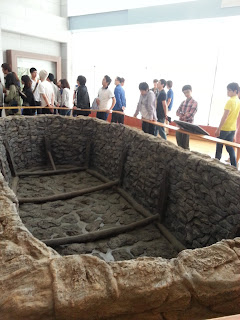순천대학교 박물관
Sunchon National University Museum
The museum was established in 1987 as the first museum of the eastern Jeolla province.
There are many exhibit halls and its collection is specialized in the ancient period of Korea(before the 10th century)
this museum is the best place to learn about the eastern Jeolla province, which has different culture with that of the western Jeolla. but the culture of the eastern Jeolla has a similarity with Gyeongsang province which located right next to it.
<검단산성>
In particular, a hall dedicated to Geomdan fortress of Sunchon (순천 검단산성 順天 劍丹山城)is important to the Baekje's history
the stone fortress was built during the sixth century by the Baekje kingdom.
through excavation, people unearthed a lot of remains and relics from the fortress.
as a result, it was designated as a historical site of Korea in 1999
the photo is a replica of a large well, found in the fortress.
it is 890 cm in length, 480 cm in width
a wooden dipper intact was also unearthed.
This coiled earthenware bottle was also excavated from the fortress.
<고인돌>
the following picture shows understructures of dolmen
In Korean dolmens, stone daggers were often found
putting a dagger in the grave is believed to have a ritual purpose driving evil spirit off from the grave.
two people praying in front of a huge stone dagger were carved on Orimdong dolmen of Yeosu, which shows ancient people's belief toward the stone dagger.
<가야 토기>
The museum also houses a lot of earthenware potteries dating to the Gaya period
as I mentioned above, it has a close correlation with the south-east area of Korea, the South Gyeongsang. this area was ruled by Gaya before the fifth or sixth century
two pottery in the picture above were chamberpots of Baekje men
<마로산성>
Maro fortress is located in Gwangyang
it is believed that it had been used from the sixth century to the 10th century.
remains of collecting wells of Maro fortress
what drew my attention was these earthen horses.
they were found in the ritual site of Maro fortress.
interesting thing was that the horse didn't have their head which means they were decapitated.
but the horses on display have their head because the museum assemble them back again.
decapitating a horse conducted when people held rites as a sacrifice.
Sunchon University Museum
http://museum.sunchon.ac.kr


















댓글 없음:
댓글 쓰기